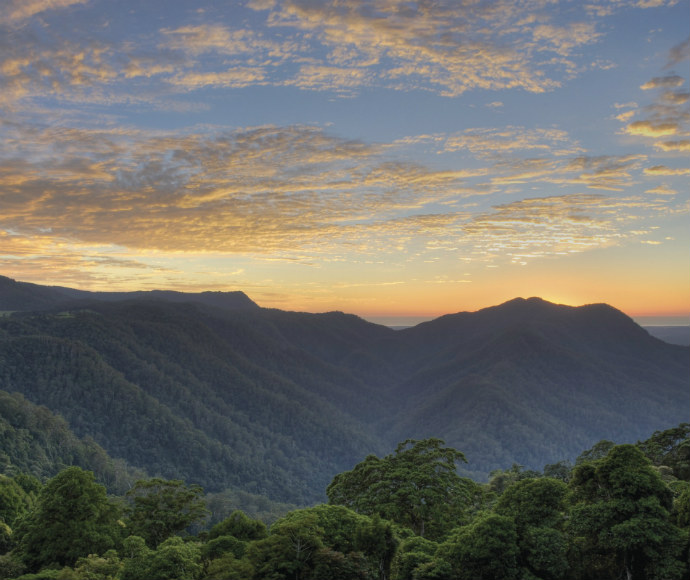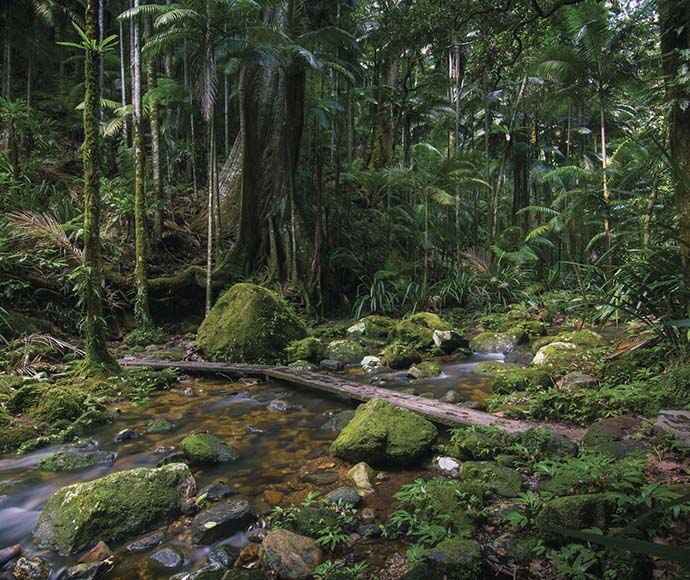This World Heritage-listed property is a series of rainforest national parks and reserves in north-east New South Wales and south-east Queensland. It contains:
- the largest areas of subtropical rainforest in the world
- nearly all the Antarctic beech cool temperate rainforest in the world
- large areas of warm temperate rainforest
- many plants and animals that are very much like their ancestors in the fossil record
- many rare and threatened species
- eroded craters of extinct shield volcanoes.

The Gondwana Rainforests of Australia include the most extensive areas of subtropical rainforest in the world.
World Heritage listing
Formerly known as the Central Eastern Rainforest Reserves of Australia, this property was first placed on the World Heritage List in 1986. The area was extended in 1994 and is World Heritage-listed because it:
... represents outstanding examples of major stages of the Earth’s evolutionary history, ongoing geological and biological processes, and exceptional biological diversity. A wide range of plant and animal lineages and communities with ancient origins in Gondwana, many of which are restricted largely or entirely to the Gondwana Rainforests, survive in this collection of reserves. The Gondwana Rainforests also provides the principal habitat for many threatened species of plants and animals. (Gondwana Rainforests, UNESCO)
Its name was changed to the Gondwana Rainforests of Australia in 2007 to better reflect the values of the property and the 40 separate reserves it covers.
The Gondwana Rainforests is also listed on the NSW State Heritage Register and the National Heritage List.

World Heritage rainforest in Nightcap National Park, near Lismore.
Management committees
On-the-ground management of the Gondwana Rainforests of Australia is largely done by the NSW National Parks and Wildlife Service (part of the Department of Climate Change, Energy, the Environment and Water), and the Queensland Parks and Wildlife Service (part of the Queensland Department of Environment, Science and Innovation).
Along with the Australian Government’s Department of Climate Change, Energy, the Environment and Water and the Queensland Department of Environment, Science and Innovation, we also manage and protect the World Heritage values of the property through threatened species programs and regional planning initiatives. Coordination of management for serial World Heritage properties is required under the World Heritage Convention.
This is achieved through cross-jurisdictional strategic planning and cooperative management by intergovernmental management committees comprising representatives of the federal Department of Climate Change, Energy, the Environment and Water, the NSW Department of Climate Change, Energy, the Environment and Water and the Queensland Department of Environment, Science and Innovation. These are the Gondwana Rainforests Management Committee and the Gondwana Rainforests Coordinating Committee.
Advisory committees
Two advisory committees, the Gondwana Rainforests of Australia Community Advisory Committee and the Gondwana Rainforests of Australia Technical and Scientific Advisory Committee, provide advice to the ministers responsible for world heritage in each jurisdiction as well as the managing agencies.